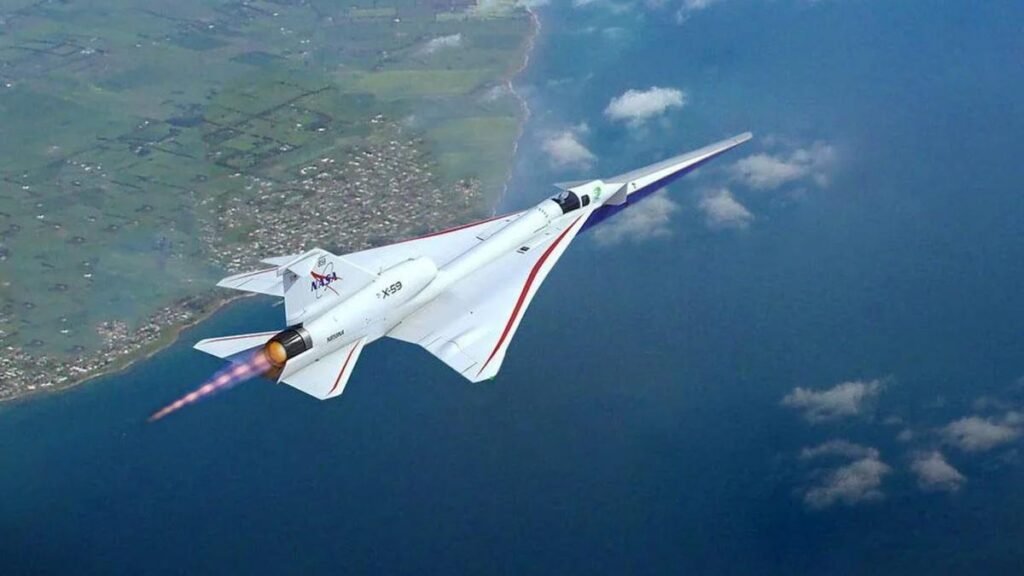From the dawn of aviation, humanity has been captivated by the allure of speed, pushing the boundaries of what was once deemed impossible. In this relentless pursuit, a new frontier has emerged – the realm of hypersonic flight, where aircraft transcend the confines of conventional propulsion and soar at velocities exceeding Mach 5, or five times the speed of sound.
The Genesis: Bumper’s Trailblazing Feat
The genesis of this extraordinary endeavor can be traced back to February 24, 1949, when a groundbreaking experiment took place at the White Sands Proving Ground. A two-stage rocket, the Bumper, comprised of a V-2 first stage and a WAC Corporal second stage, was launched into the stratosphere. As the pen plotters at South Station meticulously tracked its trajectory, the WAC Corporal ignited, propelling the rocket to a staggering velocity of 5,150 mph (8,288 km/h) and an altitude of 244 miles (393 km). In that moment, Bumper etched its name in history as the first object of human origin to achieve hypersonic flight, breaching the elusive Mach 5 barrier.
Trailblazers in the Hypersonic Realm
Since Bumper’s pioneering achievement, numerous vehicles have ventured into the hypersonic domain, each pushing the boundaries of what was once deemed unattainable. From the nose cones of intercontinental ballistic missiles to the iconic X-15 hypersonic research aircraft and the space shuttle, these marvels of engineering have redefined the limits of speed and altitude.
Harnessing the Power of Sustained Hypersonic Flight
While these vehicles have demonstrated the feasibility of hypersonic flight, their trajectories have primarily relied on gravity as the propelling force, essentially gliding back through the atmosphere after an initial boost. However, the ultimate goal lies in achieving sustained hypersonic flight within the atmosphere, a feat that could revolutionize transportation and military applications alike.
The Scramjet: Unlocking the Key to Hypersonic Propulsion
To realize this vision, researchers have turned their attention to a specialized propulsion system known as the supersonic combustion ramjet (scramjet). Unlike conventional jet engines, which are limited to subsonic and supersonic speeds, scramjets are designed to operate at hypersonic velocities, with supersonic flow throughout the entire engine.
Trailblazing Milestones: X-43 and X-51
The pursuit of this technological marvel has yielded remarkable achievements, such as the X-43 and X-51 test vehicles. The X-43, powered by a scramjet, achieved a groundbreaking 10 seconds of sustained thrust at Mach 9.6, while the X-51 operated for an impressive 200 seconds at Mach 5. These milestones, though brief, represent significant strides toward the realization of sustained hypersonic flight.
The Hypersonic Transport: A Dream on the Horizon
Beyond military applications, the allure of hypersonic flight has captivated the imagination of commercial aviation enthusiasts. The dream of a hypersonic transport, capable of whisking passengers from London to Tokyo in a mere 90 minutes, has been a tantalizing prospect for decades. While the path to this ambitious goal remains shrouded in challenges, the relentless pursuit of innovation and technological breakthroughs continues to fuel hope that this childhood dream may one day become a reality.
Overcoming the Obstacles: Aerodynamic Heating and Low-Density Flow
However, the path to hypersonic flight is not without its obstacles. One of the most formidable challenges lies in the intense aerodynamic heating experienced by vehicles traveling at such extreme velocities. The friction between the air and the high-speed object, coupled with the shock wave heating, generates temperatures that can compromise the structural integrity of the vehicle.
Another hurdle arises from the low-density flow conditions encountered at high altitudes, where the mean free path of air molecules increases significantly. In this rarefied environment, traditional aerodynamic concepts and equations based on the continuum assumption begin to break down, necessitating the application of kinetic theory to accurately model the flow dynamics.
Pioneering Endeavors: The Hypersonic Technology Vehicle 2 (HTV-2)
The Hypersonic Technology Vehicle 2 (HTV-2), a recent endeavor by the Defense Advanced Research Projects Agency (DARPA), exemplifies the challenges associated with aerodynamic heating. In August 2011, this unmanned vehicle, powered by rockets to Mach 20, experienced intense heating during its 200-second flight within the atmosphere, ultimately leading to the peeling away of its skin from the internal structure and the subsequent termination of the flight.
The Pursuit of Invincibility: Outrunning Threats
Beyond the realm of commercial aviation, the quest for hypersonic flight holds profound implications for military applications. The ability to outmaneuver and outrun threats has been a driving force behind the development of hypersonic weapons systems. The legendary SR-71 Blackbird, with its top speed of Mach 3.3, demonstrated the invincibility conferred by sheer velocity, outrunning more than 4,000 missiles fired at it during its three decades of service.
Escalating Arms Race: Hypersonic Missiles on the Horizon
However, as nations around the world, particularly Russia and China, have made significant strides in the development of hypersonic missiles, the need for a new generation of hypersonic systems has become increasingly urgent. Russia’s Kinzhal and Zircon hypersonic missiles, employed in the ongoing conflict in Ukraine, have showcased the formidable capabilities of these advanced weapons, with the Kinzhal accelerating to Mach 12 and the Zircon reaching Mach 9, while performing evasive maneuvers to evade air defense systems.
The United States’ Response: A Multifaceted Approach
In response to this escalating arms race, the United States has embarked on a multifaceted approach to hypersonic technology development. Programs such as the AGM-183A Air-Launched Rapid Response Weapon (ARRW) and the Long-Range Hypersonic Weapon (LRHW) are at the forefront of this effort, with the aim of fielding operational hypersonic weapons systems in the near future.
Collaborative Endeavors: International Partnerships
The pursuit of hypersonic flight has transcended national boundaries, with international collaborations emerging as a driving force. Nations like India, France, Australia, and Japan have joined the race, contributing their expertise and resources to this global endeavor. The joint development of air-launched hypersonic missiles between Australia and the United States, under the SCIFIRE program, exemplifies the spirit of international cooperation in this field.
Defensive Measures: Countering the Hypersonic Threat
As the proliferation of hypersonic weapons systems continues, the need for effective defensive measures has become paramount. The United States, through initiatives like the National Defense Space Architecture (NDSA) and the Proliferated Warfighting Space Architecture (PWSA), is actively developing space-based sensors and tracking systems to detect and monitor hypersonic threats.
The Hypersonic Race: A Catalyst for Innovation
Beyond the realm of military applications, the pursuit of hypersonic flight has catalyzed a wave of innovation across various sectors. Start-ups like Hermeus Aviation, based in Atlanta, Georgia, have emerged as trailblazers, backed by the US Air Force and venture capital firms. Hermeus’ ambitious plans include the development of the Quarterhorse, a hypersonic test bed capable of reaching speeds exceeding Mach 5, and the Darkhorse, a military jet intended for hypersonic operations.
Overcoming Challenges: Rapid Iteration and Agile Development
One of the key differentiators in Hermeus’ approach is their emphasis on rapid iteration and agile development. By designing, building, and flying an aircraft in less than a year, they aim to accelerate the pace of innovation and overcome the traditional multi-year development timelines that have plagued the industry.
The Chimera: A Groundbreaking Propulsion System
At the heart of Hermeus’ endeavors lies the Chimera, a revolutionary turbine-based combined cycle (TBCC) engine. This innovative propulsion system seamlessly transitions from a turbojet mode for initial acceleration to a ramjet mode for sustained hypersonic flight, effectively combining two engines into one. The successful demonstration of Chimera’s ability to transition from turbojet to ramjet power in a high-speed wind tunnel has marked a significant milestone in the pursuit of practical hypersonic flight.
Paving the Way: The Quarterhorse Test Bed
The Quarterhorse test bed serves as a crucial stepping stone in Hermeus’ journey, enabling the validation of critical systems and technologies. Through a series of iterative prototypes, ranging from the dynamic iron bird (Quarterhorse Mk0) to the flight-capable Mk1, Mk2, and Mk3 variants, Hermeus aims to progressively push the boundaries of speed, culminating in the goal of surpassing the legendary SR-71 Blackbird’s record-breaking Mach 3.2 velocity.
Collaborative Efforts: Engaging with the US Air Force
Hermeus’ endeavors have garnered the attention and support of the US Air Force, with the company securing multiple contracts, including a $60 million funding for the development of hypersonic technologies and a $950 million ceiling contract for the Advanced Battle Management System program. This collaboration underscores the strategic importance of hypersonic flight and the potential for dual-use applications in both military and commercial domains.
Beyond Speed: Redefining Transportation and Logistics
While the allure of hypersonic flight often centers around its unprecedented velocities, the implications extend far beyond mere speed. The ability to rapidly transport time-critical cargo and personnel across vast distances could revolutionize logistics and emergency response operations, enabling swift and efficient delivery of vital resources and personnel to areas of need.
Reconnaissance and Surveillance: A New Frontier
Moreover, the integration of hypersonic technologies into unmanned aerial vehicles (UAVs) opens up new frontiers in reconnaissance and surveillance missions. The combination of extreme speeds and maneuverability could provide unprecedented situational awareness and intelligence-gathering capabilities, further enhancing military operations and national security.
Overcoming Barriers: Technological Advancements and Cost Reduction
Despite the numerous challenges and obstacles that lie ahead, the relentless pursuit of technological advancements and cost reduction strategies continues to fuel the hypersonic revolution. From the development of advanced materials capable of withstanding the extreme temperatures encountered during hypersonic flight to the refinement of computational fluid dynamics (CFD) simulations and wind tunnel testing, every aspect of the endeavor is being meticulously addressed.
The Future of Aviation: Redefining Boundaries
As the world stands on the cusp of a new era in aviation, the realization of practical hypersonic flight promises to redefine the boundaries of what is possible. From slashing intercontinental travel times to enabling rapid response capabilities and enhancing national security, the implications of this technological marvel are far-reaching and profound.
Conclusion: Embracing the Hypersonic Frontier
While the path ahead is fraught with challenges and uncertainties, the indomitable spirit of human ingenuity and the relentless pursuit of knowledge continue to propel us forward. As we embrace the hypersonic frontier, we embark on a journey that will not only reshape our understanding of flight but also unlock new realms of possibility, forever etching our mark on the annals of aviation history.


